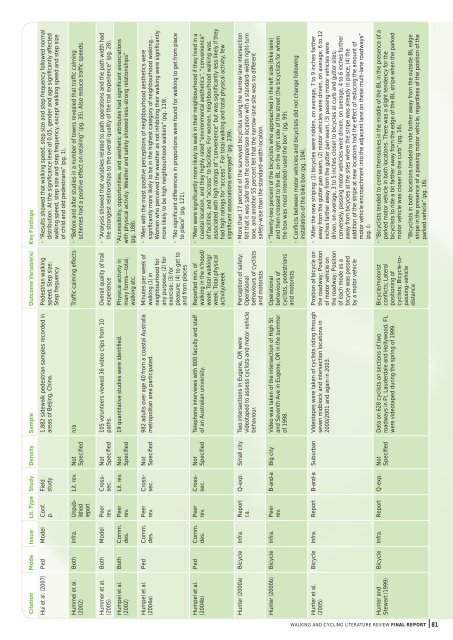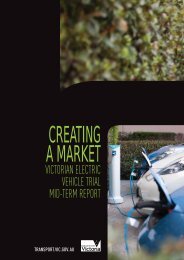Walking and Cycling International Literature Review - Department of ...
Walking and Cycling International Literature Review - Department of ...
Walking and Cycling International Literature Review - Department of ...
You also want an ePaper? Increase the reach of your titles
YUMPU automatically turns print PDFs into web optimized ePapers that Google loves.
Citation Mode Issue Lit. Type Study Density Sample Outcome Variable(s) Key Findings<br />
Hui et al. (2007) Ped Model Conf.<br />
p.<br />
Field<br />
study<br />
1,882 sidewalk pedestrian samples recorded in<br />
areas <strong>of</strong> Beijing, China.<br />
Pedestrian walking<br />
speed; Step size;<br />
Step frequency<br />
• “Results showed that walking speed, step size <strong>and</strong> step frequency followed normal<br />
distribution. At the significance level <strong>of</strong> 0.05, gender <strong>and</strong> age significantly affected<br />
walking speed, step size <strong>and</strong> step frequency, except walking speed <strong>and</strong> step size<br />
<strong>of</strong> child <strong>and</strong> old pedestrians” (pg. 1).<br />
Hummel et al.<br />
(2002)<br />
Both Infra. Unpublished<br />
report<br />
Lit. rev. Not<br />
Specified<br />
n/a Traffic calming effects • “Before <strong>and</strong> after studies in a number <strong>of</strong> towns revealed that traffic calming<br />
schemes had a positive effect on retailing” (pg. 35). Also reduce traffic speeds.<br />
Hummer et al.<br />
(2005)<br />
Both Model Peer<br />
rev.<br />
Not<br />
Specified<br />
105 volunteers viewed 36 video clips from 10<br />
paths.<br />
Overall quality <strong>of</strong> trail<br />
experience<br />
• “Analysis showed that variables related to path operations <strong>and</strong> the path width had<br />
the strongest relationships to the overall quality <strong>of</strong> the trail experience” (pg. 28).<br />
Humpel et al.<br />
(2002)<br />
Both Comm.<br />
des.<br />
Peer<br />
rev.<br />
Lit. rev. Not<br />
Specified<br />
19 quantitative studies were identified. Physical activity in<br />
many forms—total,<br />
walking etc.<br />
“Accessibility, opportunities, <strong>and</strong> aesthetic attributes had significant associations<br />
with physical activity. Weather <strong>and</strong> safety showed less-strong relationships”<br />
(pg. 188).<br />
Humpel et al.<br />
(2004a)<br />
Ped Comm.<br />
des.<br />
Peer<br />
rev.<br />
Not<br />
Specified<br />
982 adults over age 40 from a coastal Australia<br />
metropolitan area participated.<br />
Minutes per week <strong>of</strong><br />
walking (1) in<br />
neighbourhood for<br />
any purpose; (2) for<br />
exercise; (3) for<br />
pleasure; (4) to get to<br />
<strong>and</strong> from places<br />
• “Men with the most positive perceptions <strong>of</strong> neighbourhood aesthetics were<br />
significantly more likely to be in the highest category <strong>of</strong> neighbourhood walking...<br />
Women who perceived the weather as not inhibiting their walking were significantly<br />
more likely to be high neighbourhood walkers” (pg. 119).<br />
• “No significant differences in proportions were found for walking to get from place<br />
to place” (pg. 121).<br />
Humpel et al.<br />
(2004b)<br />
Ped Comm.<br />
des.<br />
Peer<br />
rev.<br />
Crosssec.<br />
Crosssec.<br />
Crosssec.<br />
Not<br />
Specified<br />
Telephone interviews with 800 faculty <strong>and</strong> staff<br />
<strong>of</strong> an Australian university.<br />
Reported min. <strong>of</strong><br />
walking in the n'hood/<br />
week; Total walking/<br />
week; Total physical<br />
activity/week<br />
• “Men were significantly more likely to walk in their neighbourhood if they lived in a<br />
coastal location, <strong>and</strong> they highly rated “environmental aesthetics”, “convenience”<br />
<strong>of</strong> facilities, <strong>and</strong> “access” to facilities. For women, neighbourhood walking was<br />
associated with high ratings <strong>of</strong> “convenience” but was significantly less likely if they<br />
had high ratings for “access”. For total walking <strong>and</strong> total physical activity, few<br />
significant associations emerged” (pg. 239).<br />
Hunter (2000a) Bicycle Infra. Report<br />
r.a.<br />
Q-exp. Small city Two intersections in Eugene, OR were<br />
videotaped to assess cyclists <strong>and</strong> motor vehicle<br />
behaviour.<br />
Perception <strong>of</strong> safety;<br />
Operational<br />
behaviours <strong>of</strong> cyclists<br />
<strong>and</strong> motorists<br />
• More than 17 percent <strong>of</strong> the surveyed bicyclists using the narrow lane intersection<br />
felt that it was safer than the comparison location with a st<strong>and</strong>ard-width right-turn<br />
lane, <strong>and</strong> another 55 percent felt that the narrow-lane site was no different<br />
safety-wise than the st<strong>and</strong>ard-width location.<br />
Hunter (2000b) Bicycle Infra. Peer<br />
rev.<br />
B-<strong>and</strong>-a Big city Video was taken <strong>of</strong> the intersection <strong>of</strong> High St<br />
<strong>and</strong> Seventh Ave in Eugene, OR in the summer<br />
<strong>of</strong> 1998.<br />
Operational<br />
behaviours <strong>of</strong><br />
cyclists, pedestrians<br />
<strong>and</strong> motorists<br />
• “Twenty-two percent <strong>of</strong> the bicyclists who approached in the left side [bike lane]<br />
<strong>and</strong> then crossed to the BL on the right side <strong>of</strong> the street (the bicyclists for whom<br />
the box was most intended) used the box” (pg. 99).<br />
• Conflicts between motor vehicles <strong>and</strong> bicyclists did not change following<br />
installation <strong>of</strong> the bike box (pg. 104).<br />
Hunter et al.<br />
(2005)<br />
Bicycle Infra. Report B-<strong>and</strong>-a Suburban Videotapes were taken <strong>of</strong> cyclists riding through<br />
seven midblock <strong>and</strong> intersection locations in<br />
2000/2001 <strong>and</strong> again in 2003.<br />
Position <strong>of</strong> bicycle on<br />
the roadway; Position<br />
<strong>of</strong> motor vehicle on<br />
the roadway; Position<br />
<strong>of</strong> each mode as a<br />
bicycle was passed<br />
by a motor vehicle<br />
• “After the new striping: (1) bicycles were ridden, on average, 7 to 9 inches farther<br />
away from the gutter pan seam, (2) motor vehicles were driven, on average, 6 to 12<br />
inches farther away from the gutter pan seam, (3) passing motor vehicles were<br />
driven, on average, 3 to 5 inches closer to bicycles at curb <strong>and</strong> gutter sites;<br />
conversely, passing motor vehicles were driven, on average, 4 to 6 inches further<br />
away from bicycles at the sites where the stripe was already in place, (4) the<br />
addition <strong>of</strong> the stripe at new locations had the effect <strong>of</strong> reducing the amount <strong>of</strong><br />
motor vehicle encroachment into the adjacent lane on these multi-lane roadways”<br />
(pg. i).<br />
Hunter <strong>and</strong><br />
Stewart (1999)<br />
Bicycle Infra. Report Q-exp. Not<br />
Specified<br />
Data on 628 cyclists on sections <strong>of</strong> two<br />
roadways in Ft. Lauderdale <strong>and</strong> Hollywood, FL<br />
were videotaped during the spring <strong>of</strong> 1999.<br />
Bicycle/motorist<br />
conflicts; Lateral<br />
positioning <strong>of</strong><br />
cyclists; Bicycle-topassing-vehicle<br />
distance<br />
• “Bicyclists tended to centre themselves in the middle <strong>of</strong> the BL in the presence <strong>of</strong> a<br />
parked motor vehicle in both locations. There was a slight tendency for the<br />
bicyclists to ride a bit farther away from the edge <strong>of</strong> the BL stripe when the parked<br />
motor vehicle was closer to the curb” (pg. 16).<br />
• “Bicyclists in both locations tended to ride farther away from the outside BL edge<br />
stripe in the presence <strong>of</strong> a passing motor vehicle, regardless <strong>of</strong> the position <strong>of</strong> the<br />
parked vehicle” (pg. 16).<br />
WALKING AND CYCLING LITERATURE REVIEW FINAL REPORT 81

















